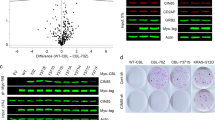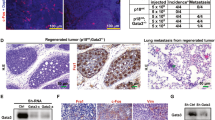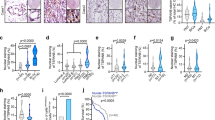Abstract
Despite the progress made in targeted anticancer therapies in recent years, challenges remain. The identification of new potential targets will ensure that the arsenal of cancer therapies continues to expand. FAM83B was recently discovered in a forward genetic screen for novel oncogenes that drive human mammary epithelial cell (HMEC) transformation. We report here that elevated FAM83B expression increases Phospholipase D (PLD) activity, and that suppression of PLD1 activity prevents FAM83B-mediated transformation. The increased PLD activity is engaged by hyperactivation of epidermal growth factor receptor (EGFR), which is regulated by an interaction involving FAM83B and EGFR. Preventing the FAM83B/EGFR interaction by site-directed mutation of lysine 230 of FAM83B suppressed PLD activity and MAPK signaling. Furthermore, ablation of FAM83B expression from breast cancer cells inhibited EGFR phosphorylation and suppressed cell proliferation. We propose that understanding the mechanism of FAM83B-mediated transformation will provide a foundation for future therapies aimed at targeting its function as an intermediary in EGFR, MAPK and mTOR activation.
This is a preview of subscription content, access via your institution
Access options
Subscribe to this journal
Receive 50 print issues and online access
$259.00 per year
only $5.18 per issue
Buy this article
- Purchase on Springer Link
- Instant access to full article PDF
Prices may be subject to local taxes which are calculated during checkout






Similar content being viewed by others

References
Grant S . Cotargeting survival signaling pathways in cancer. J Clin Invest 2008; 118: 3003–3006.
Roberts PJ, Der CJ . Targeting the Raf-MEK-ERK mitogen-activated protein kinase cascade for the treatment of cancer. Oncogene 2007; 26: 3291–3310.
Joseph T, Wooden R, Bryant A, Zhong M, Lu Z, Foster DA . Transformation of cells overexpressing a tyrosine kinase by phospholipase D1 and D2. Biochem Biophys Res Commun 2001; 289: 1019–1024.
Chien Y, Kim S, Bumeister R, Loo YM, Kwon SW, Johnson CL et al. RalB GTPase-mediated activation of the IkappaB family kinase TBK1 couples innate immune signaling to tumor cell survival. Cell 2006; 127: 157–170.
Rangarajan A, Hong SJ, Gifford A, Weinberg RA . Species- and cell type-specific requirements for cellular transformation. Cancer Cell 2004; 6: 171–183.
Foster DA, Xu L . Phospholipase D in cell proliferation and cancer. Mol Cancer Res 2003; 1: 789–800.
Shi M, Zheng Y, Garcia A, Xu L, Foster DA . Phospholipase D provides a survival signal in human cancer cells with activated H-Ras or K-Ras. Cancer Lett 2007; 258: 268–275.
Foster DA . Phosphatidic acid signaling to mTOR: Signals for the survival of human cancer cells. Biochim Biophys Acta 2009; 1791: 949–955.
Ghosh S, Bell RM . Regulation of Raf-1 kinase by interaction with the lipid second messenger, phosphatidic acid. Biochem Soc Trans 1997; 25: 561–565.
Buchanan FG, McReynolds M, Couvillon A, Kam Y, Holla VR, Dubois RN et al. Requirement of phospholipase D1 activity in H-RasV12-induced transformation. Proc Natl Acad Sci USA 2005; 102: 1638–1642.
Foster D . Targeting Phospholipase D-mediated Survival Signals in Cancer. Current Signal Transduction Therapy 2006.
Rizzo MA, Shome K, Vasudevan C, Stolz DB, Sung TC, Frohman MA et al. Phospholipase D and its product, phosphatidic acid, mediate agonist-dependent raf-1 translocation to the plasma membrane and the activation of the mitogen-activated protein kinase pathway. J Biol Chem 1999; 274: 1131–1139.
Rizzo MA, Shome K, Watkins SC, Romero G . The recruitment of Raf-1 to membranes is mediated by direct interaction with phosphatidic acid and is independent of association with Ras. J Biol Chem 2000; 275: 23911–23918.
Kraft CA, Garrido JL, Fluharty E, Leiva-Vega L, Romero G . Role of phosphatidic acid in the coupling of the ERK cascade. J Biol Chem 2008; 283: 36636–36645.
Guertin DA, Sabatini DM . Defining the role of mTOR in cancer. Cancer Cell 2007; 12: 9–22.
Cipriano R, Graham J, Miskimen KL, Bryson BL, Bruntz RC, Scott SA et al. 2FAM83B mediates EGFR- and RAS-driven oncogenic transformation. J Clin Invest 2012; 122: 3197–3210.
Cipriano R, Miskimen KL, Bryson BL, Foy CR, Jackson MW . FAM83B-mediated activation of PI3K/AKT and MAPK signaling cooperates to promote epithelial cell transformation and resistance to targeted therapies. Oncotarget 2013; 4: 729–738.
Xie Z, Ho WT, Exton JH . Association of N- and C-terminal domains of phospholipase D is required for catalytic activity. J Biol Chem 1998; 273: 34679–34682.
Brown HA, Henage LG, Preininger AM, Xiang Y, Exton JH . Biochemical analysis of phospholipase D. Methods Enzymol 2007; 434: 49–87.
Scott SA, Selvy PE, Buck JR, Cho HP, Criswell TL, Thomas AL et al. Design of isoform-selective phospholipase D inhibitors that modulate cancer cell invasiveness. Nat Chem Biol 2009; 5: 108–117.
Ladeda V, Frankel P, Feig LA, Foster DA, Bal de Kier JE, guirre-Ghiso JA . RalA mediates v-Src, v-Ras, and v-Raf regulation of CD44 and fibronectin expression in NIH3T3 fibroblasts. Biochem Biophys Res Commun 2001; 283: 854–861.
Lee SY, Meier R, Furuta S, Lenburg ME, Kenny PA, Xu R et al. FAM83A confers EGFR-TKI resistance in breast cancer cells and in mice. J Clin Invest 2012; 122: 3211–3220.
Selvy PE, Lavieri RR, Lindsley CW, Brown HA, Phospholipase D . enzymology, functionality, and chemical modulation. Chem Rev 2011; 111: 6064–6119.
Carracedo A, Ma L, Teruya-Feldstein J, Rojo F, Salmena L, Alimonti A et al. Inhibition of mTORC1 leads to MAPK pathway activation through a PI3K-dependent feedback loop in human cancer. J Clin Invest 2008; 118: 3065–3074.
Kinkade CW, Castillo-Martin M, Puzio-Kuter A, Yan J, Foster TH, Gao H et al. Targeting AKT/mTOR and ERK MAPK signaling inhibits hormone-refractory prostate cancer in a preclinical mouse model. J Clin Invest 2008; 118: 3051–3064.
Kassam F, Enright K, Dent R, Dranitsaris G, Myers J, Flynn C et al. Survival outcomes for patients with metastatic triple-negative breast cancer: implications for clinical practice and trial design. Clin Breast Cancer 2009; 9: 29–33.
Uchida N, Okamura S, Nagamachi Y, Yamashita S . Increased phospholipase D activity in human breast cancer. J Cancer Res Clin Oncol 1997; 123: 280–285.
Noh DY, Ahn SJ, Lee RA, Park IA, Kim JH, Suh PG et al. Overexpression of phospholipase D1 in human breast cancer tissues. Cancer Lett 2000; 161: 207–214.
Reich R, Blumenthal M, Liscovitch M . Role of phospholipase D in laminin-induced production of gelatinase A (MMP-2) in metastatic cells. Clin Exp Metastasis 1995; 13: 134–140.
Uchida N, Okamura S, Kuwano H . Phospholipase D activity in human gastric carcinoma. Anticancer Res 1999; 19: 671–675.
Williger BT, Ho WT, Exton JH . Phospholipase D mediates matrix metalloproteinase-9 secretion in phorbol ester-stimulated human fibrosarcoma cells. J Biol Chem 1999; 274: 735–738.
Foster DA . Regulation of mTOR by phosphatidic acid? Cancer Res 2007; 67: 1–4.
Toschi A, Lee E, Xu L, Garcia A, Gadir N, Foster DA . Regulation of mTORC1 and mTORC2 complex assembly by phosphatidic acid: competition with rapamycin. Mol Cell Biol 2009; 29: 1411–1420.
Carraway H, Hidalgo M . New targets for therapy in breast cancer: mammalian target of rapamycin (mTOR) antagonists. Breast Cancer Res 2004; 6: 219–224.
Chen Y, Zheng Y, Foster DA . Phospholipase D confers rapamycin resistance in human breast cancer cells. Oncogene 2003; 22: 3937–3942.
Cipriano R, Patton JT, Mayo LD, Jackson MW . Inactivation of p53 signaling by p73 or PTEN ablation results in a transformed phenotype that remains susceptible to Nutlin-3 mediated apoptosis. Cell Cycle 2010; 9: 1373–1379.
Patton JT, Mayo LD, Singhi AD, Gudkov AV, Stark GR, Jackson MW . Levels of HdmX expression dictate the sensitivity of normal and transformed cells to Nutlin-3. Cancer Res 2006; 66: 3169–3176.
Jackson MW, Agarwal MK, Agarwal ML, Agarwal A, Stanhope-Baker P, Williams BR et al. Limited role of N-terminal phosphoserine residues in the activation of transcription by p53. Oncogene 2004; 23: 4477–4487.
Kan CE, Patton JT, Stark GR, Jackson MW . p53-mediated growth suppression in response to Nutlin-3 in cyclin D1 transformed cells occurs independently of p21. Cancer Res 2007; 67: 9862–9868.
Acknowledgements
We are grateful to Chase Foy for technical help and Damian Junk for helpful discussions. The core facilities provided by the Case Comprehensive Cancer Center (P30 CA43703; Athymic Animal and Xenograft Core Facility; Gene Expression and Genotyping Core Facility; Cytometry and Imaging Microscopy Core Facility; Radiation Resources Core Facility). This work was supported by the US National Institutes of Health (R01CA138421 to MWJ; T32CA059366 to RC and CB), the Department of Defense Breast Cancer Research Program (BC095847 and BC074072 to MWJ), the American Cancer Society (RSG-10-072-01-TBG to MWJ) and the McDonnell Foundation for brain cancer research (HAB) and the NIH MLPCN U54 MH084659 (CWL) Vanderbilt Specialized Chemistry Center for Accelerated Probe Development.
Author information
Authors and Affiliations
Corresponding author
Ethics declarations
Competing interests
Dr Jackson's work has been funded by the NIH, the American Cancer Society, and the Department of Defense. Dr H Alex Brown's work has been funded by the McDonnell Foundation. Dr Cipriano's and Ms Bartel's work has been funded by the NIH. The remaining authors declare no conflict of interest.
Additional information
Supplementary Information accompanies this paper on the Oncogene website
Supplementary information
Rights and permissions
About this article
Cite this article
Cipriano, R., Bryson, B., Miskimen, K. et al. Hyperactivation of EGFR and downstream effector phospholipase D1 by oncogenic FAM83B. Oncogene 33, 3298–3306 (2014). https://doi.org/10.1038/onc.2013.293
Received:
Revised:
Accepted:
Published:
Issue Date:
DOI: https://doi.org/10.1038/onc.2013.293
Keywords
This article is cited by
-
Structural insights into PA3488-mediated inactivation of Pseudomonas aeruginosa PldA
Nature Communications (2022)
-
FAM83B is involved in thyroid cancer cell differentiation and migration
Scientific Reports (2022)
-
The phospholipase D inhibitor FIPI potently blocks EGF-induced calcium signaling in human breast cancer cells
Cell Communication and Signaling (2021)
-
Targeting phospholipase D in cancer, infection and neurodegenerative disorders
Nature Reviews Drug Discovery (2017)
-
Multiple across-strain and within-strain QTLs suggest highly complex genetic architecture for hypoxia tolerance in channel catfish
Molecular Genetics and Genomics (2017)


